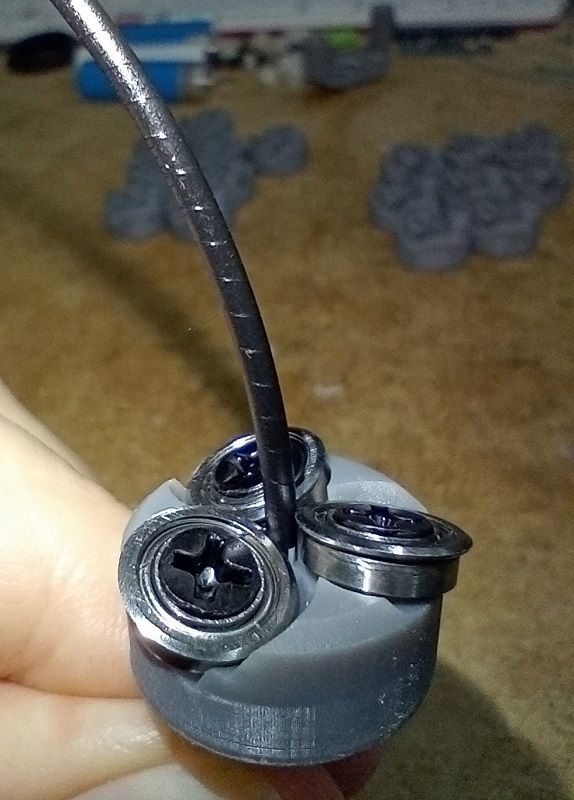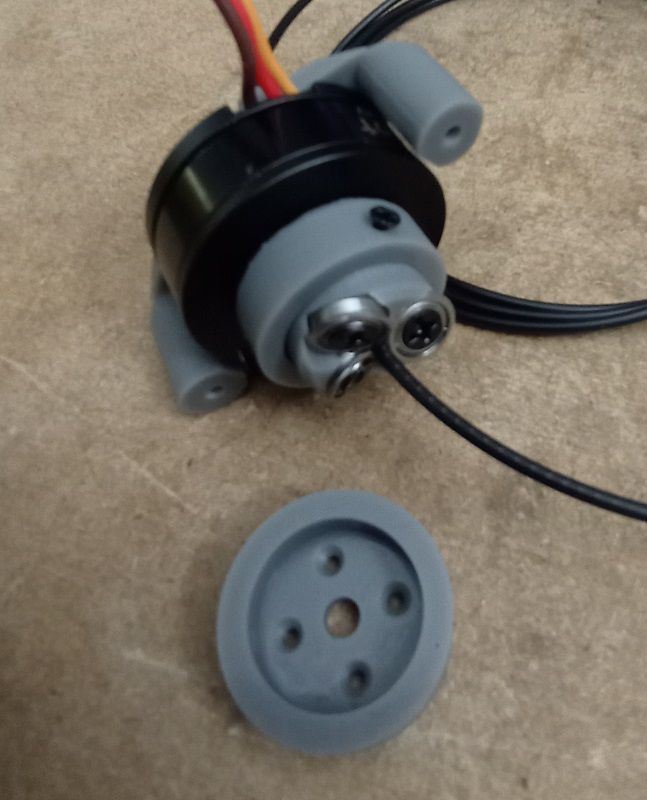Hollow shaft extruder
-
I pushed myself over the edge and ordered an PD30 optical disk encoder with 512ppr.
The wiring and tech-specs are a bit confusing as usual. I hope it's an ABI type... -
@tombrazier Yep. I don't think I linked that correctly.
-
The bearings arrived and I made a big batch of both carrier versions.
It works nice and smooth spinning it by hand.
It's too early to review the threeBB. I'll let him do some weightlifting soon.
The carriers in the background are freebies for guinee pigs (a small donation for stamps and envelops is welcome) . They come without bearings tho.
PM me for detailsI'll send five of each to @tombrazier, so users in UK may ask him...unless he wants to keep them all for himself

He might also be able to tell us more about the grinding process.
-
@o_lampe What did the weight end up?
-
@breed I don't know if my scale would even notice it. Tom weighted his with 5grams.
I'll add an BLDC adapter and motor carrier for the smartEffector first. -
@o_lampe said in Hollow shaft extruder:
He might also be able to tell us more about the grinding process.
My video shows how to do it with any old sanding disk or belt sander on just one side of the flange. The same method is easily adaptable for use with a Dremel cutting disk to grind both sides of the flange.
-
@tombrazier I was more concerned about the required diameter of the flange? In your video, you used very tight tolerances.
-
@o_lampe Wich Resin did you use?
The Temperatur near the Extruders is about 60 °C, sometimes higher.
Thats why I ´m a little bit worried about fixturing the skrews in the plastic.May be I can try it with Formlabs dental materials.
This is a very nice Project - sorry about my english

Gruß zero K
-
@zero-K I'm using ABS-like which has a very high glass temperature. The Sherpa-Mini is made of it too and it works on my delta printer with NEMA14 stepper for about a year and hasn't shown signs of softening.
The BLDC motor doesn't even get warm because of sineWave FOC and a clever current control. -
@o_lampe Thank you for your answer.
Phrozens Resin is cheap compared with them of our Formlabs printers.
I think, a foreign Resin can not be allowed in our Printers and post processing - not only because of bio compatibility - may be too - adjusting the parameters of Laser. For private use, some risk.I will try it first with "Surgical Guide" - Only for testing I have sterilized parts out of this Resin 10 times 20 min at 134°C. I like this Resin very much. If a first try lasts 100 h printing, it would be a nice result because its quite brittle.
3D-printing is not my job - its like play ground and hobby.
I would let you know.
Gruß, zero K
-
@o_lampe I would be interested in a carrier (and a set of bearings ...). DM me for arrangement of exchange of goods or so (-:
-
@CNCModeller hi, I will be getting 5 samples from LDO, likely by end of September. Counting you, those samples will go to
@jay_s_uk
@tombrazier
@CNCModeller
@MaxGyver
@oliofSo this round is closed. Jason from LDO graciously will provide the samples for free, so please DM me your postal address and I will get back to you about shipping costs as soon as the samples arrive.
If these turn out to be good, MOQ for production unfortunately clocks in at 100 ... nothing I can spring from my own pockets.
-
@o_lampe In a way, the diameter itself is not all that important because you can just print a carrier to match whatever diameters your bearings came out at. e.g. one of the carrier models I sent you has bearing diameters of 9.88mm, 9.6mm and 9.1mm because, after a lot of experimenting, those were the bearings I had to spare. But if you can get them all to the same diameter it does simplify matters.
What does matter is that the edge is symmetrical. Bite depth is quite small. I use 0.1mm. So if the edge on the bearing is slightly ovoid or has flat spots you'll get bits where the extruder doesn't grip. My method of grinding produces a symmetrical edge quite reliably - as long as the bearing is free to rotate whilst it is being ground. With a bit of practice it's fairly easy. The time consuming part is when you're trying to get all the bearings to the same diameter and have to keep measuring.
-
@zero-K My extruder hardly warms up at all, but I am using a much higher torque motor than needed. The motor I have specced for LDO is going to run at higher current. But I think it will be able remain below 60°C, especially if you don't want to be extruding at speeds like 30mm^3/s. For a small amount more weight it would definitely be possible to keep temperatures nice and low.
-
@tombrazier I was wondering about mf84 bearings. They are popular size in rc cars. Should have good selection of quality bearings.
-
For the BLDC version I had to make a collar for the carrier and added three small screws for clamping the carrier.
@oliof @tombrazier Did you talk to Jason about pressfitting the carrier to the shaft? He might be able to make the shaft-end rougher for a better grip?Tom, I wouldn't be surprised if part of the underextrusion at higher speeds are caused by a slipping carrier?

-
@breed I think they'd work fine. I have found that making the diameter of the flange as large as possible helps with extrusion force. I guess this is because with a larger radius of curvature there is more overlap between flange and filament. As the MF84 is an 8mm OD bearing it will presumably have a flange of a little over 9mm, same as MF85ZZ. When I tried with three MF95ZZ, which have a little over 10mm flange diameter I found the flanges tended to interfere with each other. So both MF85ZZ and MF84 are almost ideal. I say almost because 2 MF95ZZ plus one 9mm flange works and that gives you the most filament overlap possible. But it is asymmetrical, which has its issues.
The major difference between MF84 and MF85ZZ is the inner diameter. With your shoulder screw design this is fine, but for my design I think an inner diameter of 5mm with an M3 screw down the centre of the bearing support is likely to be about the smallest you can go.
-
@o_lampe said in Hollow shaft extruder:
Tom, I wouldn't be surprised if part of the underextrusion at higher speeds are caused by a slipping carrier?
No, I have checked that. The torque requirement is really small and the carrier doesn't come close to slipping even against the full holding torque of the motor. Also, all the underextrusion I have reported has been from compression of the helical thread because it is actually thread pitch that I am measuring.
For the BLDC version I had to make a collar for the carrier and added three small screws for clamping the carrier.
That should work. Another solution, of course, is a slightly redesigned carrier.
Did you talk to Jason about pressfitting the carrier to the shaft? He might be able to make the shaft-end rougher for a better grip?
Very interesting and timely question.
-
@oliof what LDO motor were you getting sampled?
-
@breed hollow shaft motor as specced by @tombrazier for his revision of the VDE.